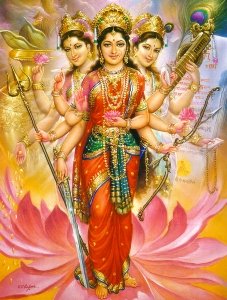Essence Of Devi Bhagavatha Purana |
|
 |
Nara and Narayana, Urvasi and Prahlada Maha Muni Dharma was born from Lord Brahma’s heart and was wedded to Prajapathi Daksha’s ten daughters. He had four sons Hari, Krishna, Nara and Narayana. The former two were practitioners of high system of Yoga and Nara and Narayana were always engaged in religious means. When Nara and Narayana were performing rigourous meditation at Gandhamadan Mountain for over one thousand years, Indra got alarmed at the safety of his throne and despatched Celestial Damsels like Rambha, Tilottama, Menaka totalling sixteen thousand and also requested Manmadha and Rati Devi to help divert the attention of the Sages. |
All the coquetisth approaches made by Heavenly Nymphs fell flat as these Sages were far above the aspects of lust and anger. With a smile, the Sage brothers created one outstandingly beautiful woman from their thighs and hence named Urvasi! The Munis said that since there were so many Nymphs who came from Heavens to visit the place, they thought it fit to create at least one hostess to look after them. The Apsaras were put to shame as their intention was different and fell on the feet of the Sages. They were all grateful that despite the deep provocation that the Munis had faced, they did not curse the Apsaras; instead the Munis asked to take away Urvasi also and leave them in peace to continue their ‘Tapasya’. But the Apsaras desired to stay at the most alluring surroundings of the Mountain and begged of Narayana to marry them as they were all got mesmerised and infatuated with him. On their collective insistence, Sage Narayana agreed that in His next Avatar as Lord Krishna, He would marry them all and with that assurance, they returned back to Indra Loka. As the Apsaras left, the Sages Nara and Narayana did not get angry with the disturbance caused by the presence of so many damsels and spoilt their Tapasya, as anger and ‘Ahamkara’ (Ego) would indeed be worse than lust and thus reverted back to their ‘Tapasya’. In fact the Sages felt that a position like that happened earlier when they were overcome by the instinct of ‘Ahamkara’ and their meditation was badly affected when there was a fight with Prahlada and that they would never like to repeat a situation like that. Veda Vyasa explained to King Janamyejaya that Illustrious Sages like Nara Narayanas or even the ever-memorable devotee of Lord Vishnu like Prahlada, who was responsible for the slaughter of Hiranya Kasipu by Lord Vishnu’s Incarnation of ‘Narasimha’, were not exceptions to ‘Ahamkara’, let alone ordinary human beings! The son of Bhrigu Maharshi, Chyavana Muni was bathing in Narmada River at a ‘Punya Kshetra’ ( a Holy Place) named Vyarhitisvara. A frightful snake pulled the Muni and dragged him down to Patala. The Muni felt that his last hours of life were counted as the snake would surely give him a poisonous bite any time and prayed to Lord Vishnu most sincerely wondering how awful was fate that after a highly ascetic life he had to have an end like this! But, the poison proved ineffective as his prayers were responded to. In Patala, the snake felt apologetic for its action and revered the Muni for his powers. Others nearby too respected the Sage and the word went round till the King of Patala, Prahlada called him and realised that Chyavana Muni too was a close devotee of Lord Vishnu. During the conversation with the Sage, Prahlada realised how enlightened the Muni was and enquired which were the best pilgrimage places on earth for visits. The Muni replied that if there were no pollution in one’s own mind, every place would be a pilgrimage center and if the mind was full of vice, avarice, and violence, no pilgrimage was worth it. In any case, Chyavana Muni recommended Prahlada’s visit to Naimisharanya and the nearby Chakra Tirtha and Pushkara Tirtha and so on. Prahlada was excited and visited Naimisaranya and noted that there were several Sages engaged in their own Tapasyas. But, suddenly he saw a sight of two Munis with knotted hair, keeping before them two sets of bows and arrows, ‘Sarangam’ and ‘Ajavagam’ (Pinaka) belonging to Lords Vishnu and Siva. The Sages were indeed Nara and Narayana. Prahlada was furious to see the sight of the Sages keeping bows and arrows before them and at the same time engaged in deep meditation. He felt that both bravery and meditation could never be side by side and neither of these qualities was genuine. He reprimanded and badly criticised the Sages, who asked the King to mind his business and leave them alone. Then arguments followed by the King and the ascetics and the King gradually became louder and quarrelsome. The spirit of ‘Ahankara’ overcame both the sides and snow-balled into a fulfledged battle! The entire Universe got reverberated with the exchange of fiery arrows from Nara and Narayana on the one hand and Prahlada and the entire army of Asuras on the other for several years. It became apparent over the time that the two Sages were indeed invincible and Prahlada was almost overcome; he remembered Maha Vishnu who appeared before the devotee. Bhagavan Vishnu declared to Prahlada that the Great Sages Nara and Narayana were of His own ‘Amsa’( Expansion). Realising his grave blunder, Prahlada fell on the feet of the Sages and prayed to them that ‘Ahamkara’ blinded him and ‘Maya’overpowered his emotions, for which he was ashamed and guilty! |
|
| Devi Bhagavata Purana Home |
Back to the News Page